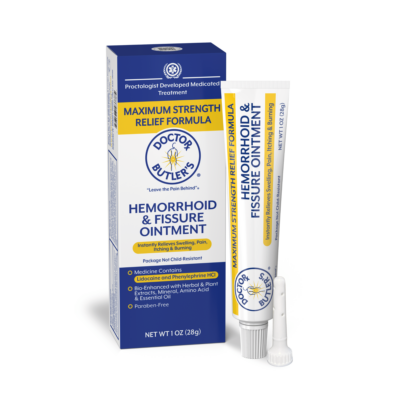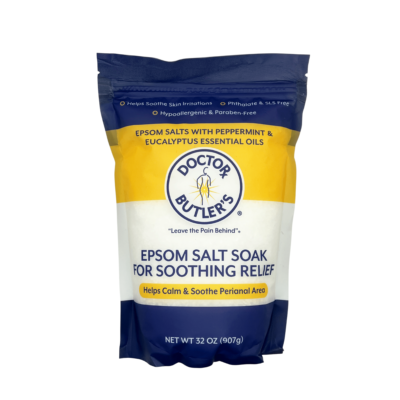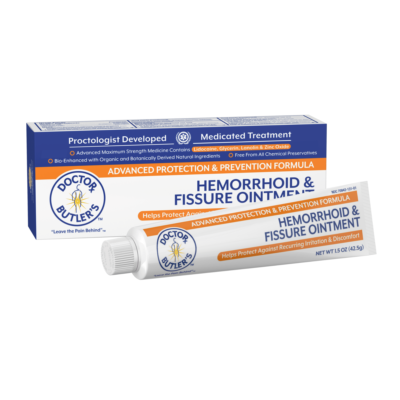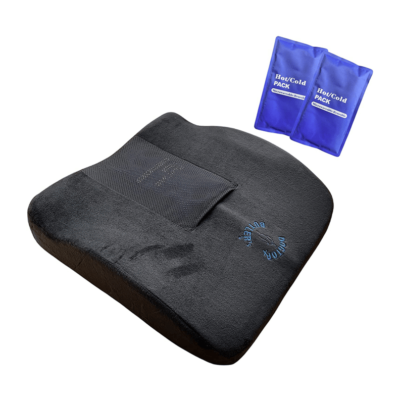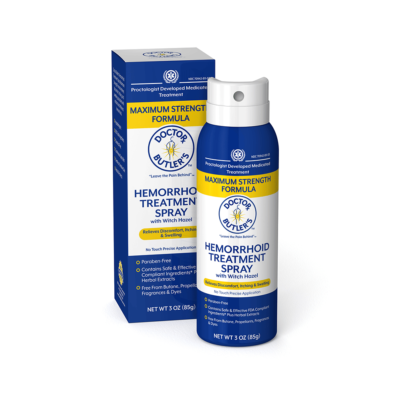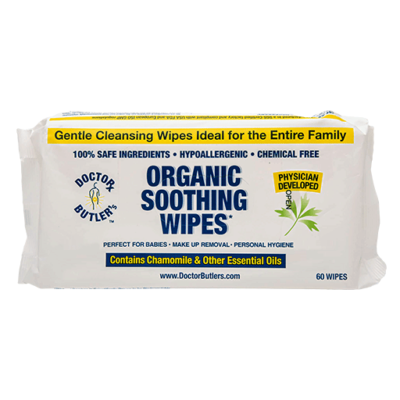To get rid of hemorrhoid pain and find hemorrhoid relief quickly, there are a few routes available. If you’ve never had hemorrhoids before, we first recommend a medicated ointment, because that’s what we’ve found to be easiest and it works for most people. There are a few ointment options out there, though we like Lidocaine based ointments (that’s what we use) and will explain more on why below.
Who are we? We’re Doctor Butler’s, experts in down-there care of hemorrhoids and related conditions. We make proctologist-developed hemorrhoid ointments and complementary products to help you quickly leave the pain behind. Dr. Robert Cutler medically reviews all of the information here.
“Best Help Ever! This product is better than the prescription my doctor gave. I’m sticking with what works.”
Verified ReviewerIf you have had hemorrhoids before but are looking for different treatment options, there are other ointment formulations with different active ingredients, such as Phenylephrine, Pramoxine, Hydrocortisone, or Zinc Oxide that may work better for you. Scroll down to the Hemorrhoid Ointments and Creams section if that’s what you’re looking for.
And there are, of course, many natural and home remedies that may be effective, though possibly less convenient than a purpose made cream. Still, many patients will benefit from their use, especially when used alongside an OTC.
Some natural solutions include applications of witch hazel, aloe vera and treatments like a warm sitz bath. They’re tried and true remedies, but their effectiveness only goes so far if it’s the only thing you’re doing to combat hemorrhoid pain.
Furthermore, there are some treatments you may have read about elsewhere online that you should avoid. We’ll talk about those below. If you already know the basics about hemorrhoids, feel free to skip the next couple paragraphs where we’ll be reviewing what hemorrhoids are in order to help people new to the condition better understand treatment options.
Click here to scroll right down to the best hemorrhoid treatments recommended by Dr. Cutler, Doctor Butler’s founder and product developer.
Hemorrhoids: Symptoms
Hemorrhoids are swollen blood vessels located in the lower rectum, anal canal, and on the exterior ridge of the anus opening. This diagram shows the difference between where internal and external hemorrhoids develop.
Via Michael McCullough on flickr
Depending on where hemorrhoids are located and how long they’ve been left untreated, they can be classified in different ways. The different types of hemorrhoids include Internal hemorrhoids, External hemorrhoids, Prolapsed hemorrhoids, and Thrombosed hemorrhoids.
Internal hemorrhoids are where hemorrhoids start. This kind of hemorrhoid exists in the rectum (above the anal canal, which only extends two inches into the anal cavity). These hemorrhoids are usually asymptomatic and most people won’t realize they have a hemorrhoid problem from internal hemorrhoids aside from itching or bright red blood that may end up on toilet tissue.
External hemorrhoids form on the rim of the anus, and are usually what people refer to when they speak about hemorrhoids generally. That’s because these are the kinds of hemorrhoids that usually cause pain, itching, and burning and swell up causing problems going to the bathroom and living comfortably. Location is the only distinguishing factor between internal and external hemorrhoids.
A Prolapsed hemorrhoid is an internal hemorrhoid that has become stretched out by repeated trauma (bowel movements passing over it) so that it elongates to the point that it falls out of the anal cavity.
At this point, the normally painless internal hemorrhoid is susceptible to some of the painful symptoms of external hemorrhoids (mainly caused by trauma from cleaning up after bowel movements). It’s possible to push the hemorrhoid back into the anal cavity though it may be painful and the chances of it coming out again are high.
Finally, a Thrombosed hemorrhoid is an internal or external hemorrhoid in which a blood clot has formed from trauma (wiping after bowel movements in most cases). The intense itching, burning, pain, redness, and swelling that accompanies a thrombosed hemorrhoid is often more severe than other cases of hemorrhoids, but OTC treatment is just as effective.
One again, we can differentiate hemorrhoids in a basic way by splitting them into four categories:
- Internal Hemorrhoids
- External Hemorrhoids
- Prolapsed Hemorrhoids
- Thrombosed Hemorrhoids
Hemorrhoids: Causes
Hemorrhoids are caused by excess straining and weight on the perineal region. Hemorrhoid sites are so prone to flare ups because they’re filled with blood vessels that can sometimes inflame when there’s too much pressure on the area, causing to vessel to swell out into the anal cavaity and in the way of passing bowel movements.
Activities that cause this pressure include difficult bowel movements (i.e. pushing really hard), weight lifting, carrying a baby while pregnant. People particularly prone to hemorrhoids include pregnant and obese people because of the excess weight carried by the body.
Hemorrhoids: Diagnosis
Hemorrhoids are not too difficult to self diagnose in most cases, though a trip to the doctor is essential to rule out advanced conditions or complications. External hemorrhoids can be seen or felt from outside. Diagnosing internal hemorrhoids requires a doctor to perform a digital rectal exam or a visual exam with an anoscope.
For external hemorrhoids you can visually inspect the area using a mirror. Look and feel for a bump. External hemorrhoids will bulge from the skin and be sensitive to touch, and are extremely painful in many cases.
A sign of internal hemorrhoids will be bright red blood on toilet tissue after a bowel movement. These hemorrhoids are harder to diagnose because of their location in the anal cavaity and rectum and because they are generally pain free except for mild to moderate itching. A doctor will likely need to diagnose internal hemorrhoids for you.
The other kind of hemorrhoids discussed above including prolapsed and thrombosed hemorrhoids are just variations on internal and external hemorrhoids. Each should be cared for with a treatment plan prescribed by your doctor, though there are some tried and true treatments most patients will benefit from that we’ll go over below.
Best Hemorrhoid Relief Treatments Recommended by Dr. Cutler
Find a treatment plan with your doctor that includes some of the following recommendations. Many can be used in conjunction with one another to help keep pain and irritation at bay throughout the day and night. Some non-medicated treatments like sitz baths and cold compresses can be used one after another to manage pain continuously.
We’ll cover some of the best hemorrhoid pain relief treatments, non medicated and medicated, right now!
1. Sitz Baths
You can take a sitz bath in a dedicated device that sits over your toilet bowl or in your bathtub. All a ‘sitz bath’ is, as most people refer to it, is a soak in warm water for about 15 minutes. So simply fill the bottom of a tub or sitz bath basin with enough warm water to cover the affected area.
You can do this as much as you’d like, and it’s especially helpful after bowel movements to reduce pain and cleanse the area when wiping is too difficult. Add bath salts to the sitz bath for added inflammation reduction.
“Best Help Ever! This product is better than the prescription my doctor gave. I’m sticking with what works.”
Verified Reviewer2. Hemorrhoid Ointments and Creams
Hemorrhoid ointments are handy because of their convenience and potent formulas. You can get relief from a sitz bath and other options below like ice packs and witch hazel treatments, but all of these require active treatment, whereas with ointments and creams you can apply and go about your day.
Additionally, ointments can sometimes help treat the actual issue rather than just reduce symptoms. Ointments with protectants, for example, provide a protective layer to stop further irritating an already inflamed hemorrhoid. That’s exactly what we did with our Advanced Formula, which you can read more about here:
“Best Help Ever! This product is better than the prescription my doctor gave. I’m sticking with what works.”
Verified ReviewerYou have multiple options when selecting an ointment or cream. Lidocaine, Phenylephrine, Pramoxine, Hydrocortisone, and Zinc Oxide are the most common active ingredients for hemorrhoid ointments and creams. Here’s a quick overview of how each one works:
- Lidocaine: This is a topical anesthetic that numbs pain by blocking the pathways from the skin to the brain. Lidocaine is a popular drug for many conditions involving topical pain (and gets lots of use in dental procedures and epidurals during pregnancy as well).
This is the main ingredient in our formulas. (We actually introduced this to the OTC hemorrhoid ointment market in 2006!) Previously only available at 2 or 3% in hemorrhoid prescriptions, Lidocaine at 4 or 5% has become a standard ingredient in hemorrhoid ointment because of its quick numbing properties and fast absorption.
- Phenylephrine: This ingredient helps reduce swelling. It’s a vasoconstrictor which means that it reduces the width of the blood vessels in the region it’s applied, slowing blood flow. Blood vessels expand and contract on their own, and this induces them to shrink which is helpful for a hemorrhoid swollen with blood.
- Pramoxine: This is a topical anesthetic that stops nerves from sending pain signals to the brain, much like Lidocaine. Pramoxine, however, “exhibits a potency less than that of lidocaine while they have a comparable duration” of effectiveness, a 2018 study concluded.
- Hydrocortisone: This is a corticosteroid (aka man-made steroid, though different from the kinds of hormone-based steroids used illicitly by athletes for example). It works by reducing the activity of the body’s immune system. Typically the immune system fights against things like bacteria and infections by increasing blood flow to an area, but in the case of hemorrhoids you actually want to reduce that activity to let the swelling go down. That’s why hydrocortisone can be an effective treatment.
- Zinc Oxide: This is a mineral based astringent with some soothing properties that acts as a physical barrier to help prevent irritation allowing skin time to heal. In hemorrhoid ointments it will be labeled as an astringent on the drug facts panel but it makes a good protectant as well (hence its widespread use in sunscreen).
You may find multiple active ingredients in one formulation. Preparation H, for example, now also has a Lidocaine ointment with Phenylephrine, much like our Maximum Strength ointment. Their formula does not contain our proprietary mix of excipient ingredients that includes herbs, essential oils, minerals, and amino acids. And, ours is paraben free.
Ointments are a good place to start if you’re newly affected by hemorrhoids because of their convenience and high potency pain relief. But here a few more treatments to try first if you’re looking for some solutions around the house:
3. Cold Compresses
An ice pack (aka cold compress) can greatly reduce hemorrhoid pain. Just don’t apply it to your bare bottom. Wear breathable clothes and make sure to use it on a seat that won’t be damaged from some water dripping off the ice pack. This treatment will help reduce some pain, burning and swelling.
“Best Help Ever! This product is better than the prescription my doctor gave. I’m sticking with what works.”
Verified Reviewer4. Witch Hazel
Witch hazel is a natural astringent and can be found in many wipes and sprays made for hemorrhoid problems. But you can also buy it in its pure form at most drug stores. Make sure you purchase a 100% witch hazel product and not one that contains alcohol. This will hurt your hemorrhoids. When used correctly, witch hazel can reduce symptoms and swelling.
Here are instructions from our resource page on using witch hazel for hemorrhoids:
“The most simple way to treat external hemorrhoids with witch hazel is to soak cotton balls in comfortably warm witch hazel and apply it to the hemorrhoid site for 15 minutes, 3 to 4 times daily. For this treatment, you can use pure witch hazel and warm it up on the stove or in the microwave.
If you find that 100 percent witch hazel is drying and irritates your affected area, try a more diluted product like witch hazel pads or a purpose-made spray.”
You can find witch hazel in our ready-made hemorrhoid spray. Learn more here:
“Best Help Ever! This product is better than the prescription my doctor gave. I’m sticking with what works.”
Verified Reviewer5. Aloe Vera
Aloe vera is a natural soothing agent that will help to reduce some pain and burning. If you have an aloe plant around the house, feel free to try it out, but be careful not to touch your hemorrhoids with any of the sharp edges. Instead, cut out the gel inside the plant and apply gently.
There are, of course, prepared Aloe Vera gels but they are rarely formulated for hemorrhoids specifically. They can help reduce some symptoms if it’s pure aloe, but avoid it if it has added ingredients.
Additionally, you can find aloe as an inactive ingredient in various hemorrhoid ointments including Doctor Butler’s, Preparation H, and more.
6. Psyllium Husk
Adding Psyllium Husk is a great way to up your fiber intake, which we recommend for anyone having irregular bowel movements. Irregular bowel movements, whether constipation or diarrhea, both cause hemorrhoids. By addressing the source of your hemorrhoids with psyllium husk and other fiber you’ll help get rid of them in the long term.
Psyllium Husk won’t do anything for the pain you’re feeling right now, just to be clear.
7. Soothing Wipes
As mentioned above in the witch hazel section, you can find a lot of wipes for hemorrhoids that are formulated with witch hazel. Look for a wipe that contains 10% or more witch hazel. That’s the amount at which it’s considered an OTC wipe and will be able to help reduce swelling.
Wipes in general can be helpful when dealing with hemorrhoids because they are softer than toilet paper, which can be rough and hurt inflamed hemorrhoids. Even though a wipe may not be medicated (in fact, none of our wipes are!), it can still help with hemorrhoids simply because the wet cloth won’t tug on your irritated skin as you wipe.
We have an organic wipe and a flushable wipe.
“Best Help Ever! This product is better than the prescription my doctor gave. I’m sticking with what works.”
Verified Reviewer“Best Help Ever! This product is better than the prescription my doctor gave. I’m sticking with what works.”
Verified Reviewer8. Mineral Oil
If you are having firm bowel movements, drink two Tablespoons of mineral oil daily as a lubricant. This will help the stool pass by irritated hemorrhoids with ease. Just be sure to limit your intake of mineral oil to two weeks at most since it has been known to decrease vitamin absorption when taken long term.
Hemorrhoid Treatments You Should Avoid
Doctor Butler’s was started by Dr. Robert Cutler, a board certified anorectal practitioner, who’s treated patients with hemorrhoids for more than 30 years. His advice about home treatment?:
“I’ve had many patients come to me after trying home remedies and failing. Unfortunately what’s happened in recent years is there’s a lot of information put online that isn’t medically accurate or doesn’t fully explain best practices for use” says Dr. Cutler.
The truth is that something as simple as a sitz bath can be incredibly effective in reducing symptoms temporarily and should be used while treating hemorrhoids, but it can’t be the only thing you do if you want your relief for hemorrhoid pain to last. And what’s worse is if a home remedy is concocted incorrectly and hurts someone more than it helps.
Dr. Cutler notes that the following two treatments are ones that have caused the most recurring patient problems. For that reason we can not recommend them:
1. Apple Cider Vinegar
Apple cider vinegar is a natural astringent. Astringents shrink tissue which can help with swollen hemorrhoids. Anecdotally apple cider vinegar is praised endlessly, though there’s little scientific evidence of its effectiveness.
The thing about apple cider vinegar is it may reduce symptoms but it has to be diluted with water, and if you don’t dilute it enough it can actually make your hemorrhoids worse. We don’t recommend it for this reason. There are better treatments available but if you’re going to try it make sure to only add as much as two cups of apple cider vinegar to a bath filled with 2 to 3 inches of water and soak.
Do not apply pure apple cider vinegar to your hemorrhoids on skin. It will make them worse.
2. Tea Tree Oil
Similar to apple cider vinegar, tea tree oil will hurt more than it helps if not diluted enough. It may be effective at reducing hemorrhoid symptoms if used properly, according to anecdotal evidence. So while we don’t recommend it because we’ve seen how it can hurt some people, if you want to try it here’s what you do:
Dilute it in a mixture of coconut oil or in water. For a coconut oil mixture, add a few drops of tea tree essential oil to at least one tablespoon of coconut oil. Then mix and apply to a cotton ball and press lightly on the affected area. For a sitz bath, add a few drops of tea tree essential oil to a bathtub filled with 2 to 3 inches of water and soak.
When to Seek Professional Help for Hemorrhoids?
If the conditions of your hemorrhoids don’t improve after a week or get worse, it is recommended to contact a medical professional. You may need to receive medical treatment from a licensed professional.
Possible medical treatments for hemorrhoid relief may include:
- Rubber band ligation.
- Surgical removal.
- Sclerotherapy.
Find Relief From Hemorrhoids With Doctor Butler’s Remedies
Home treatment for hemorrhoids isn’t as difficult as you might think. In fact, we like to break it down into three simple steps.
- Stop the swelling
- Relieve the discomfort
- Change your hemorrhoid-causing habits
Swollen hemorrhoids should be addressed right away to prevent further complications to your hemorrhoids. By reducing the size of your hemorrhoids with medicine like phenylephrine, you physically get them out of the way of bowel movements and other things that keep them inflamed. Continuously swollen hemorrhoids can cause permanent skin tags, etc.
Painful hemorrhoid symptoms can also be addressed right away (even though we put Relief as Step 2 above!). A HUGE part of the hemorrhoid healing process is to get your mind off the hemorrhoid with pain relieving medicine or treatment. Hemorrhoids need time to heal, and relief makes that time easier.
Step 3 is the trickier one because it involves preventing hemorrhoids, when possible, by changing your behavior. That might mean altering your diet to include more fiber if you’re frequently constipated or your stools are too firm. Drinking a lot of water, too, can help in situations like these. We have resources to help you get started on this in our Ask The Doctor archives.
To stop swelling and reduce pain right now, try our Maximum Strength hemorrhoid ointment, made with both Phenylephrine and Lidocaine to shrink hemorrhoids and relieve burning, itching, and other painful symptoms of hemorrhoids. Once you tackle the swelling and the immediate pain, you’ll be able to relax and let the healing begin.
